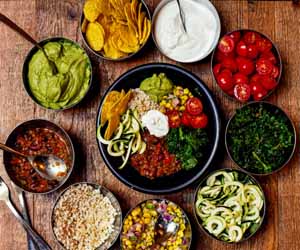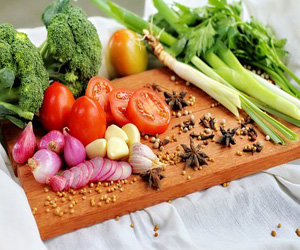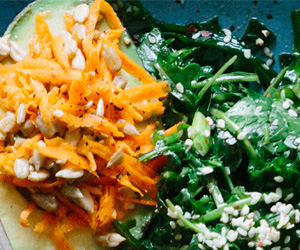


A Culinary Journey Of Health And Flavor

Mediterranean cuisine is more than just a style of cooking; it's a way of life. Rooted in the countries that surround the Mediterranean Sea, this dietary tradition has captivated food enthusiasts worldwide. Renowned for its exceptional flavors and health benefits, it's a testament to how culture, climate, and nature converge to create a harmonious culinary experience.
Fresh, Seasonal Ingredients: At the heart of Mediterranean cuisine is an unwavering commitment to using fresh, seasonal ingredients. Luscious tomatoes, vibrant bell peppers, succulent olives, aromatic herbs, and a bounty of fruits and vegetables are staples. The emphasis on seasonality not only ensures the freshest, most flavorful ingredients but also connects individuals to their environment and allows them to savor the unique tastes that each time of year brings.
Olive Oil, The Liquid Gold: Olive oil is the cornerstone of Mediterranean cooking. It's not only used for its health benefits but is the primary source of fat in this diet. Rich in monounsaturated fats and antioxidants, olive oil is a vital ingredient in Mediterranean recipes, contributing to the cuisine's heart-healthy reputation.
Lean Proteins: Mediterranean cuisine values lean protein sources. Fresh seafood, including fish like salmon, sardines, and mackerel, is a regular feature. Legumes like chickpeas and lentils, as well as poultry, are also commonly consumed. Red meat is enjoyed in moderation, typically on special occasions.
Flavorful Herbs And Spices: Mediterranean dishes are characterized by the liberal use of herbs and spices like oregano, basil, thyme, rosemary, and cumin. These seasonings infuse the cuisine with complex, aromatic flavors. They not only enhance the taste of the dishes but also provide health benefits due to their antioxidant properties.
Whole Grains: Whole grains are integral to Mediterranean cuisine. Dishes often feature grains like bulgur, quinoa, farro, and couscous. These grains are a source of fiber and nutrients, contributing to the overall healthfulness of the diet.
Community And Togetherness: Mediterranean cuisine is not just about what's on the plate but also about the social experience of dining. Meals are often shared with loved ones, and the communal aspect of eating is deeply cherished. This sense of togetherness enhances not just the flavors but also the overall sense of well-being.
Health Benefits: The Mediterranean diet is well-known for its health benefits. Numerous studies have shown that it can reduce the risk of heart disease, lower the risk of certain cancers, and improve cognitive function. Its emphasis on fresh, whole foods, and the presence of healthy fats and antioxidants contribute to these advantages.
A Global Influence: Mediterranean cuisine has had a profound impact on global cooking. Restaurants and home kitchens around the world draw inspiration from this dietary tradition, incorporating Mediterranean flavors and ingredients into diverse culinary experiences.
Mediterranean cuisine is a celebration of fresh, colorful, and wholesome ingredients that deliver an explosion of flavor and a plethora of health benefits. It's a holistic approach to eating that respects the rhythms of nature, the joys of community, and the importance of savoring every bite. As you embark on a culinary journey inspired by the Mediterranean, you not only experience the pleasures of gastronomy but also nurture your health and well-being. In every dish, there's a story of culture, tradition, and a love for food that transcends borders.
The Quest For The Ultimate Cup
 2. Grinding: The grind size of the coffee beans is crucial. It must be just right, neither too fine nor too coarse, to achieve optimal extraction. Professional-grade grinders allow minute adjustments to ensure precise control over the grind size.
2. Grinding: The grind size of the coffee beans is crucial. It must be just right, neither too fine nor too coarse, to achieve optimal extraction. Professional-grade grinders allow minute adjustments to ensure precise control over the grind size.
3. Water Quality: The quality of the water used is a often overlooked but critical factor. Clean, fresh water with the right mineral content is essential for brewing the perfect shot. It ensures that the flavors in the coffee are accentuated and not masked by impurities.
4. Brewing Temperature: Water temperature plays a fundamental role in extracting the desired flavors from the coffee grounds. Espresso demands hot water, typically between 195°F and 205°F (90°C to 96°C), to fully extract the complex aromatic compounds from the beans.
5. Pressure: Espresso machines apply high pressure, usually between 9 and 15 bars, to force hot water through the coffee grounds. This pressure not only ensures efficient extraction but also creates the luscious crema, the golden layer that tops the espresso.
6. Brewing Time: The brewing time is finely tuned, usually around 25-30 seconds. It's a delicate balance where a few seconds can make a profound difference in the taste and aroma.


Reducing Environmental Footprints
 3. Consumer Demand: As consumers become more eco-conscious, they actively seek products with sustainable packaging, influencing manufacturers to adapt their practices.
3. Consumer Demand: As consumers become more eco-conscious, they actively seek products with sustainable packaging, influencing manufacturers to adapt their practices.
4. Regulatory Pressure: Governments and organizations are imposing regulations and guidelines to encourage or mandate sustainable packaging practices.
Sustainable Packaging Elements:
To achieve eco-friendliness, sustainable packaging incorporates various elements:
1. Recycled Materials: Using recycled materials for packaging helps reduce the need for new resource extraction and minimizes waste.
2. Biodegradability: Some sustainable packaging materials are designed to break down naturally, reducing the impact on the environment.
The Art Of Elevating The Dining Experience
 The Ingredients Of Culinary Excellence:
The Ingredients Of Culinary Excellence:
Culinary excellence encompasses a blend of key elements, all of which come together to create unforgettable dining experiences:
1. Creativity And Innovation: At the heart of culinary excellence is creativity. The most celebrated chefs and culinary artists are known for pushing the boundaries, experimenting with flavors, and devising new ways to present familiar ingredients. Innovation drives the evolution of culinary arts, leading to exciting and diverse dishes.
2. Exceptional Skill And Technique: Culinary excellence demands unwavering dedication to honing one's skills. Mastery of various cooking techniques, from sous-vide cooking to knife skills, is essential for chefs and culinary professionals. The artistry in mastering the craft is what sets culinary excellence apart.
 What Are Anti-Inflammatory Foods?
What Are Anti-Inflammatory Foods?
Anti-inflammatory foods are those that help to reduce chronic inflammation in the body. They do this by containing specific compounds that have natural anti-inflammatory properties. These foods include a wide range of fruits, vegetables, nuts, seeds, and herbs.
Some of the most well-known anti-inflammatory foods include:
Berries: Blueberries, strawberries, and raspberries are packed with antioxidants, particularly flavonoids, which have potent anti-inflammatory effects.
Fatty Fish: Salmon, mackerel, and sardines are rich in omega-3 fatty acids, which have been shown to reduce inflammation in the body.
Leafy Greens: Spinach, kale, and Swiss chard are abundant sources of vitamins, minerals, and antioxidants that help combat inflammation.
Turmeric: This spice contains curcumin, a powerful anti-inflammatory compound with a wide range of health benefits.
Nuts And Seeds: Almonds, walnuts, flaxseeds, and chia seeds are high in healthy fats, fiber, and antioxidants that reduce inflammation.
Olive Oil: Extra virgin olive oil is known for its anti-inflammatory properties and is a staple of the Mediterranean diet.
Tomatoes: Tomatoes are rich in lycopene, an antioxidant that helps reduce inflammation.
The Health Benefits Of Anti-Inflammatory Foods
Consuming anti-inflammatory foods can have a profound impact on health. Some of the benefits include:
Where Science And Craft Converge
 The choice of ingredients plays a pivotal role in brewing. Whether it's the selection of coffee beans, tea leaves, hops, malt, or other elements, the brewer becomes a curator, choosing the best raw materials to create a masterpiece. Much like an artist selecting their palette, the brewer's choices will dictate the colors and flavors of the final creation.
The choice of ingredients plays a pivotal role in brewing. Whether it's the selection of coffee beans, tea leaves, hops, malt, or other elements, the brewer becomes a curator, choosing the best raw materials to create a masterpiece. Much like an artist selecting their palette, the brewer's choices will dictate the colors and flavors of the final creation.
Temperature is a critical factor in brewing. The ideal range may vary depending on the beverage and the brewing method, but precision is non-negotiable. A slight variation in temperature can lead to vastly different outcomes. Coffee brewed at the wrong temperature can become over-extracted or under-extracted, while beer fermentation temperatures can profoundly affect the taste and aroma.
Time is another essential element. The brewer must possess patience and timing skills akin to a seasoned chef. The steeping duration for tea, the brewing time for coffee, or the fermentation period for beer all contribute to the final flavor profile. Like a painter, the brewer waits for the right moment to unveil the masterpiece.
 Health And Nutrition: One of the most significant advantages of homemade cooking is the ability to control the quality and nutritional value of your meals. You have full control over the ingredients you use, allowing you to create dishes that align with your dietary preferences and health needs. This control extends to portion sizes, helping you manage your calorie intake and make informed choices about what you eat.
Health And Nutrition: One of the most significant advantages of homemade cooking is the ability to control the quality and nutritional value of your meals. You have full control over the ingredients you use, allowing you to create dishes that align with your dietary preferences and health needs. This control extends to portion sizes, helping you manage your calorie intake and make informed choices about what you eat.
Customization And Creativity: Homemade cooking is a canvas for culinary creativity. Whether you're following a cherished family recipe or experimenting with new flavors, the kitchen is where you can showcase your creativity. You can adapt recipes to suit your taste, experiment with different ingredients, and personalize your dishes to perfection.
Cost-Effective Dining: Eating out at restaurants can be costly, while homemade cooking provides an affordable alternative. Cooking at home allows you to stretch your budget, save money, and make the most of your ingredients. You can also plan meals in advance, reducing food waste and making your groceries go further.
More Than Just A Full Stomach
 Comfort And Tradition: Certain dishes and meals hold a special place in our hearts due to their comforting and traditional nature. These are the meals that evoke childhood memories, cultural heritage, and the warmth of home. A bowl of grandma's soup or a holiday feast can provide a sense of nostalgia and security, offering more than just physical satisfaction.
Comfort And Tradition: Certain dishes and meals hold a special place in our hearts due to their comforting and traditional nature. These are the meals that evoke childhood memories, cultural heritage, and the warmth of home. A bowl of grandma's soup or a holiday feast can provide a sense of nostalgia and security, offering more than just physical satisfaction.
Mindful Eating: Mealtime satisfaction also embraces the concept of mindful eating. It's about being present in the moment, savoring each bite, and appreciating the nourishment that food provides. Mindful eating encourages us to eat with intention, to listen to our bodies, and to make conscious choices about what and how we consume.
Well-Being And Health: Satisfying meals contribute to overall well-being and health. When we are satisfied with our meals, we are less likely to overeat or indulge in unhealthy choices.